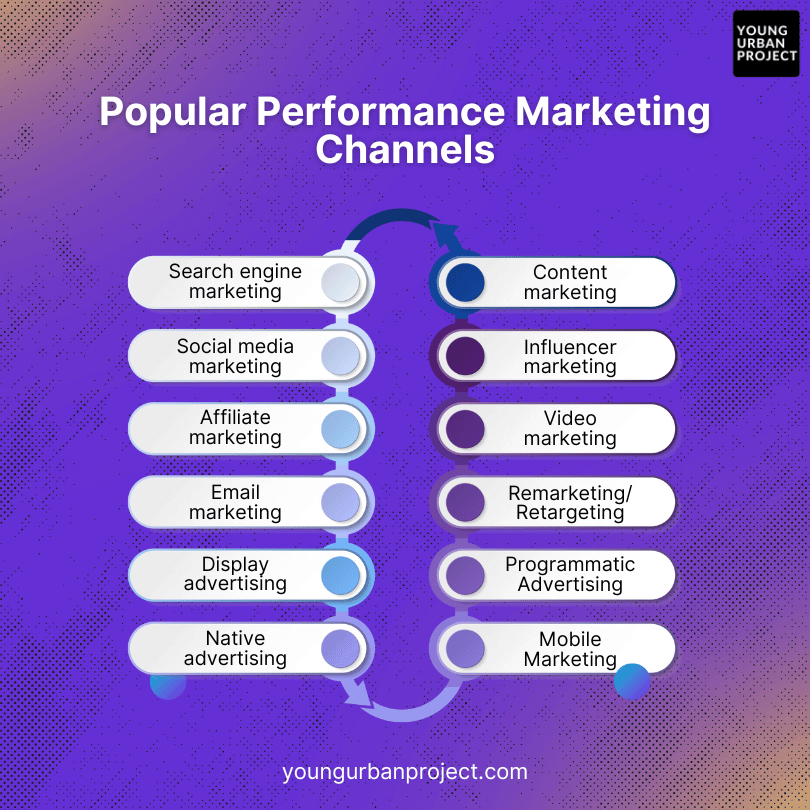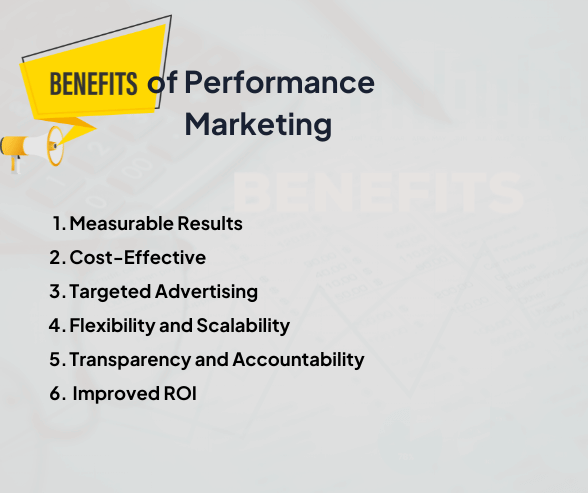Performance marketing has become an essential strategy for businesses aiming to achieve measurable results and maximize their return on investment (ROI). Unlike traditional marketing methods that focus on brand awareness and reach, performance marketing is driven by specific actions such as clicks, leads, sales, and other conversions. In this comprehensive guide, we’ll explore various performance marketing channels that can boost your business, providing real-world examples to help you understand each concept better.
What is Performance Marketing?
Performance marketing is a digital marketing strategy where advertisers pay for specific actions rather than general exposure. These actions can include clicks, leads, sales, and other conversions that directly contribute to a business’s bottom line. It relies heavily on analytics in performance marketing to track success, ensuring every dollar is spent effectively. Performance marketing encompasses various channels such as search engine marketing (SEM), social media advertising, affiliate marketing, and email marketing, all aimed at achieving measurable and cost-effective results.
Key Performance Marketing Channels

Performance marketing channels refers to the various pathways that help a brand reach their target audience, and acquire customers.
Most people think that performance marketing campaigns are all about paid channels. However, that is far from true. Performance strategy doesn’t operate in silos. Across the funnel, it can include pure-play paid channels (like SEM, Social Media Advertising, Display Advertising), or Owned Channels (like Social media marketing, email marketing, WhatsApp marketing), or even earned channels.
Let’s look at some of the prominent performance marketing channel marketers love to inlclude in their media mix.
1. Search Engine Marketing (SEM)
Search Engine Marketing (SEM) is a digital marketing strategy focused on increasing a website’s visibility in search engine results pages (SERPs) through paid advertising. SEM involves bidding on keywords that users might enter when searching for products or services. Ads appear at the top of search results, and advertisers pay only when someone clicks on their ad (pay-per-click or PPC). SEM allows businesses to target specific audiences based on keywords, demographics, and geographic location. It is highly effective for driving immediate traffic to websites and achieving specific marketing goals, such as increasing sales or leads.
Example: A local bakery (like le15 patisserie in Mumbai) wants to attract more customers. By using Google Ads and targeting keywords like “best bakery near me,” they can display their ads to users actively searching for bakery products. They pay only when someone clicks on their ad, ensuring they only spend money when potential customers show interest.
2. Social Media Advertising
Social Media Advertising is a form of digital advertising that utilizes social media platforms to promote products or services. It involves creating and placing ads on platforms like Facebook, Instagram, Twitter, LinkedIn, and TikTok. These ads can be targeted based on user demographics, interests, behaviors, and geographic location. Social media advertising aims to increase brand awareness, drive website traffic, generate leads, and boost sales. It offers various ad formats such as image ads, video ads, carousel ads, and sponsored posts, providing businesses with versatile options to engage their target audience effectively on social media channels.
Example: A fitness apparel brand targets (like Under Armour) users interested in health and wellness on Instagram. By creating visually appealing ads and using Instagram’s targeting options, they can reach potential customers who are more likely to engage with their content and make a purchase.
Optimize Your Ad Spend with Facebook Ads Budget Calculator
3. Affiliate Marketing
Affiliate Marketing is a performance-based marketing strategy where businesses reward affiliates for driving traffic or sales to their website through the affiliate’s marketing efforts. Affiliates promote products or services using unique affiliate links provided by the business. When a customer makes a purchase or performs a specified action through the affiliate link, the affiliate earns a commission. This model benefits both businesses, as they gain increased exposure and sales without upfront marketing costs, and affiliates, who earn passive income by leveraging their audience and marketing skills. Affiliate marketing is widely used across various industries due to its cost-effectiveness and measurable results.
Example: An online electronics store partners with tech bloggers and influencers. These affiliates review and recommend products to their audience, earning a commission for every sale made through their unique affiliate links.
Read More: What is Performance Marketing?
4. Email Marketing
Email marketing is a digital marketing strategy that involves sending targeted emails to a group of subscribers or customers. These emails can be used to promote products or services, share company news or updates, build customer relationships, and drive sales. Email marketing campaigns can range from promotional newsletters and product announcements to personalized offers and automated drip campaigns. Effective email marketing relies on delivering relevant content to the right audience at the right time, fostering engagement and loyalty. It remains a powerful tool for businesses to communicate directly with their audience and achieve various marketing objectives efficiently.
Example: An e-commerce site (like Amazon, or Flipkart) sends personalized email offers to customers who abandoned their shopping carts. By providing a special discount, they encourage these potential customers to complete their purchase.
5. Display Advertising
Display advertising is a form of online advertising that involves placing visual ads on third-party websites to reach a targeted audience. These ads, often in the form of banners, images, or rich media, are strategically placed on websites that are relevant to the advertiser’s target market or demographic.
The primary goal of display advertising is to attract attention and generate brand awareness or direct response actions such as clicks or conversions. Ads can be targeted based on factors like demographics, interests, behaviors, and location, making them highly effective in reaching specific audiences.
Example: A travel agency (like MakeMyTrip) uses display ads to target users who have recently searched for vacation destinations. By showcasing attractive travel packages, they capture the interest of potential travelers and drive traffic to their booking site.
Optimize your ad campaigns with our Google Ads Cost Calculator
6. Native Advertising
Native advertising is a form of online advertising that seamlessly integrates into the platform’s user experience. Unlike traditional display ads, native ads match the look, feel, and function of the content surrounding them. They are designed to blend in with editorial content, social media feeds, or other digital environments, making them less disruptive and more engaging for users. Native ads aim to deliver valuable content while promoting products or services subtly. This approach enhances user experience by providing relevant information within the context of the platform, thereby increasing engagement and driving brand awareness and conversions effectively.
Example: A financial services company (lke Zerodha) publishes a sponsored article on a popular finance blog. The article provides valuable investment tips while subtly promoting the company’s services, leading to increased brand credibility and customer interest.
7. Content Marketing
Content marketing is a strategic marketing approach focused on creating and distributing valuable, relevant, and consistent content to attract and retain a clearly defined audience — and, ultimately, to drive profitable customer action. This content can take various forms, such as blog posts, articles, videos, infographics, and eBooks. The goal of content marketing is to provide valuable information to potential customers, build trust, and establish authority in the industry. By delivering useful content that addresses the needs and interests of your target audience, content marketing aims to drive engagement, generate leads, and nurture customer loyalty over time.
Example: A software company (Like Odoo) publishes a series of blog posts and eBooks on topics related to their products. By providing valuable information, they attract potential customers to their website, which they can then convert through other marketing efforts.
Read more: How Does Performance Marketing Work?
8. Influencer Marketing
Influencer marketing is a strategy that focuses on leveraging the authority and reach of individuals who have a dedicated and engaged following on social media platforms. Influencers, who are typically experts or personalities in specific niches, collaborate with brands to promote their products or services to their audience. This form of marketing relies on the influencer’s credibility and relationship with their followers to drive awareness, engagement, and ultimately, conversions for the brand. Influencer marketing campaigns can take various forms, including sponsored posts, product reviews, giveaways, and endorsements, allowing brands to reach targeted audiences authentically through trusted voices in their respective communities.
Example: A cosmetics brand collaborates with a beauty influencer on YouTube. The influencer creates a tutorial using the brand’s products, encouraging their followers to purchase them through a special discount code.
9. Video Marketing
Video marketing is a digital marketing strategy that uses video content to promote products, services, or brands. It involves creating and sharing videos on platforms like YouTube, Facebook, Instagram, TikTok, and LinkedIn to engage audiences and achieve marketing goals. Video marketing can take various forms, including explainer videos, product demonstrations, testimonials, live streams, and behind-the-scenes footage. It is effective in capturing attention, conveying messages quickly and memorably, and driving user engagement. Video content is highly versatile and can be optimized for different platforms and audiences, making it a powerful tool for businesses to enhance brand visibility, educate consumers, and increase conversions
Example: A home improvement company creates DIY tutorial videos on YouTube, demonstrating how to use their products. These videos attract a large audience, many of whom are likely to purchase the products featured in the tutorials.
Read More: A/B Testing vs Multivariate Testing
10. Remarketing
Remarketing, also known as retargeting, is a digital marketing strategy that involves targeting users who have previously interacted with your website or mobile app. This technique allows advertisers to show ads to these users as they browse other websites or use other apps.
The goal of remarketing is to re-engage potential customers who have shown interest in your products or services but haven’t completed a desired action, such as making a purchase or filling out a form. By staying top-of-mind with personalized ads, remarketing helps businesses increase brand awareness, encourage return visits, and ultimately, boost conversions. It leverages user data and behavioral insights to deliver relevant ads that are more likely to resonate and drive action.
Example: An online clothing retailer uses Google Ads to remarket to users who viewed specific products but didn’t buy. These users see ads for the same products on other websites, increasing the likelihood of them returning to complete their purchase.
11. Programmatic Advertising
Programmatic advertising (one of the lesser used performance marketing channels) is an automated method of buying and optimizing digital ad placements in real time through an auction-based process. It utilizes advanced algorithms and software to purchase ad space across websites, apps, and digital platforms.
Unlike traditional ad-buying methods that involve negotiations and manual insertion orders, programmatic advertising uses data-driven insights and targeting parameters to reach specific audiences effectively. This approach allows advertisers to target users based on factors such as demographics, interests, behaviors, and geographic location with precision.
Example: An automobile company (like Hyundai) uses programmatic advertising to target users interested in buying a new car. By analyzing data and behaviors, they serve ads to users most likely to convert, maximizing their ROI.
12. Mobile Marketing
With the increasing use of smartphones, mobile marketing has become crucial. This includes SMS marketing, in-app advertising, and mobile-optimized ads that reach users on their mobile devices.
Example: A restaurant chain sends SMS coupons to customers, offering discounts on their next visit. This direct and timely approach encourages customers to visit the restaurant and take advantage of the offer.
Read More: Performance Marketing vs Digital Marketing
Benefits of Performance Marketing

Performance marketing offers a range of benefits that make it an attractive strategy for businesses looking to optimize their marketing efforts and achieve measurable results. Here are some of the key benefits of performance marketing:
1. Measurable Results
One of the most significant advantages of performance marketing is its focus on measurable outcomes. Unlike traditional marketing methods that can be challenging to quantify, performance marketing allows you to track specific actions such as clicks, conversions, and sales. This data-driven approach enables you to measure the effectiveness of your campaigns accurately.
Read More: Top Performance Marketing Tools
2. Cost-Effective
Performance marketing operates on a pay-for-performance model, meaning you only pay when a specific action is completed. This cost structure ensures that your marketing budget is spent efficiently, targeting only those activities that generate tangible results.
3. Targeted Advertising
Performance marketing allows for precise targeting based on demographics, interests, behaviors, and more. This targeted approach ensures that your ads reach the most relevant audience, increasing the likelihood of conversions.
Read More: Performance Marketing Challenges & their Solutions
4. Flexibility and Scalability
Performance marketing campaigns can be easily adjusted and scaled based on performance data. If a particular campaign is performing well, you can increase your budget to maximize results. Conversely, if a campaign is underperforming, you can make adjustments or reallocate your budget to more effective strategies.
5. Transparency and Accountability
Performance marketing provides clear and transparent Performance Marketing Metrics, ensuring greater accountability for marketing efforts. With real-time data access, you can accurately track campaign performance and make informed decisions to optimize results.
6. Improved ROI
By focusing on measurable outcomes and optimizing campaigns based on performance data, performance marketing can significantly improve your return on investment. This approach ensures that your marketing efforts are directly tied to business goals, leading to more efficient use of resources.
Conclusion
Performance marketing channels allow businesses to achieve measurable results and maximize their ROI. By effectively understanding and utilizing these channels, you can create targeted campaigns that drive conversions and boost your business. Each channel has its strengths, and the best approach often involves a combination of several methods to reach your audience across multiple touchpoints.
Remember, the key to successful performance marketing is continuous monitoring and optimization. Regularly analyze your campaigns, adjust your strategies based on performance data, and stay updated with the latest trends and technologies to stay ahead in the competitive digital landscape.

